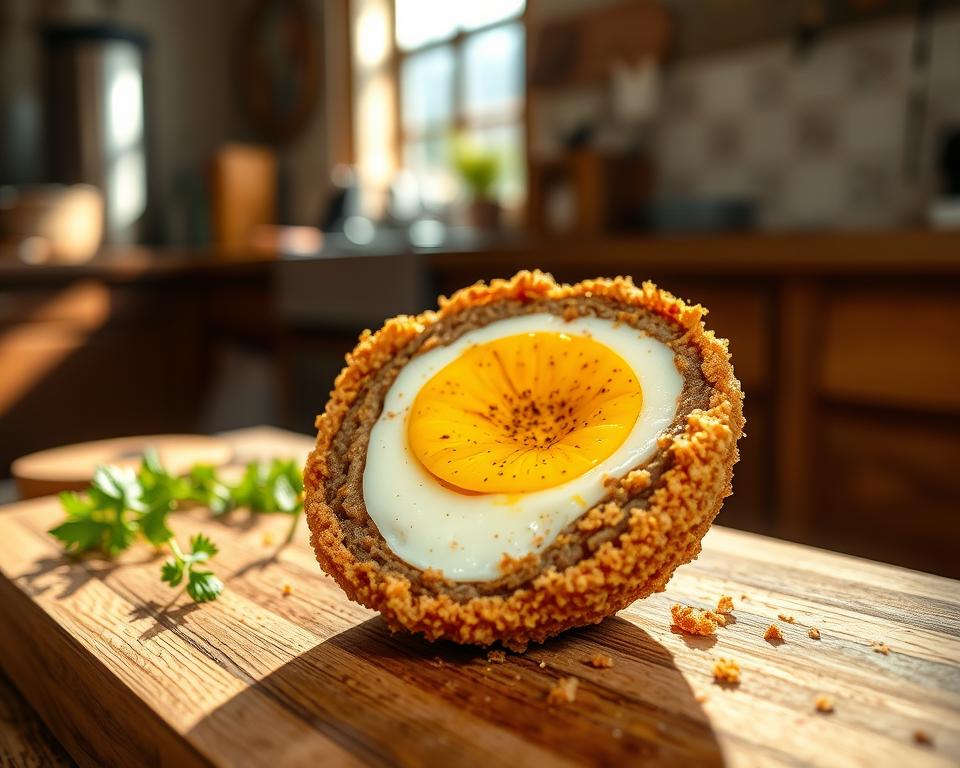Imagine a dish that combines the rich flavors of pork sausage, the creaminess of a perfectly boiled yolk, and the satisfying crunch of golden breadcrumbs. This is the magic of the classic British snack, the scotch egg. With roots dating back to the 18th century, this dish has stood the test of time as a beloved picnic staple and hearty appetizer.
What makes this recipe special is its balance of indulgence and nutrition. Packed with protein from the sausage and eggs, it’s a filling option for breakfast, lunch, or even a quick snack. The prep time is just 20 minutes, and with a cook time of 30 minutes, you can have this flavorful dish ready in under an hour.
Whether you’re hosting a gathering or simply craving a comforting treat, this recipe is a winner. You’ll learn how to achieve the perfect crispy crust and discover expert tips to elevate the flavors. Let’s dive into this timeless British classic and make it your new go-to dish!
Key Takeaways
- Discover the traditional British roots of this hearty and flavorful dish.
- Enjoy a protein-packed snack or meal with minimal prep and cook time.
- Learn how to create the perfect crispy crust for a satisfying crunch.
- Use high-quality ingredients like pork sausage and eggs for the best results.
- Perfect for picnics, breakfast, or as a quick appetizer.
Introduction: The Journey of a British Classic
This iconic dish combines simplicity and indulgence in every bite. The scotch egg has a fascinating history that dates back to the 18th century. While its name might suggest Scottish origins, it’s widely believed to have been created in England. Fortnum & Mason, the famous London department store, claims to have invented it as a portable snack for travelers.
Discovering the Recipe’s Origin
The scotch egg’s journey is as rich as its flavor. Originally, it was a simple yet ingenious idea: a boiled egg wrapped in seasoned sausage meat, coated in breadcrumbs, and fried to golden perfection. Over time, chefs have reimagined the recipe, experimenting with different types of sausage and egg varieties. From spicy chorizo to quail eggs, the possibilities are endless.
Exploring the Health Benefits of Key Ingredients
Beyond its delicious taste, the scotch egg is packed with nutritional benefits. Eggs are a fantastic source of protein, essential for muscle repair and energy. The sausage adds another layer of protein, along with healthy fats that keep you full longer. Together, these ingredients make the dish a satisfying and wholesome option for any meal.
“The scotch egg is a perfect example of how simple ingredients can create something extraordinary.”
Whether you’re enjoying it as a snack, a picnic treat, or a hearty breakfast, the scotch egg offers both flavor and nutrition. Its versatility and rich history make it a dish worth exploring further.
Scotch Eggs: A Traditional British Treat
Few snacks can match the satisfying blend of textures and flavors found in a classic British treat. This dish has been a favorite for centuries, offering a delightful mix of softness, richness, and crunch. Its enduring popularity lies in its simplicity and the way it brings together humble ingredients into something extraordinary.

What Makes Scotch Eggs Unique?
At its core, this dish is a perfectly boiled egg wrapped in seasoned sausage meat. The double coating of flour, beaten egg, and breadcrumbs gives it a signature crunch that’s hard to resist. This combination of textures—soft, rich, and crispy—is what sets it apart.
Its versatility is another reason for its popularity. Whether you enjoy it as a hearty snack, a picnic treat, or a pub appetizer, it always hits the spot. Modern variations have added even more excitement to the classic recipe. Chefs now experiment with different types of sausage, from spicy chorizo to herb-infused pork, and adjust the egg’s firmness to suit personal preferences.
- Soft or jammy yolk: The heart of the dish, offering a creamy contrast to the crispy exterior.
- Seasoned sausage: Adds depth of flavor and a satisfying meaty texture.
- Double coating: Flour, egg, and breadcrumbs create the perfect crunch.
This dish is more than just a snack; it’s a celebration of British culinary tradition. Its unique texture and flavor have made it a beloved treat across generations. Whether you stick to the classic recipe or try a modern twist, each bite is a journey through history and innovation.
Breaking Down the Recipe: Ingredients and Method
Mastering the art of this classic dish starts with understanding its core components and techniques. The process involves three main steps: preparing the sausage and egg combination, breading, and cooking. Each step is crucial to achieving the perfect balance of textures and flavors.
Preparing the Sausage and Egg Combination
Begin by boiling the eggs until they’re just set, then peel them carefully. Next, take your seasoned sausage and divide it into equal portions. Flatten each portion into a thin patty, ensuring it’s large enough to wrap around the egg completely.
Gently press the sausage around the egg, making sure there are no gaps. This step is key to keeping the filling intact during cooking. Lightly dust the outer layer with flour to help the breading stick better.

Breading, Frying, and Baking Explained
For the breading, prepare three bowls: one with flour, one with beaten egg, and one with breadcrumbs. Roll the sausage-wrapped egg in flour, dip it in the beaten egg, and then coat it thoroughly with breadcrumbs. Repeat the egg and breadcrumb layers for extra crunch.
Heat oil to 375°F for deep-frying. Carefully place the coated eggs into the hot oil and fry until golden brown, about 4-5 minutes. Alternatively, you can bake them at 350°F for 20-25 minutes for a healthier option. Both methods deliver a crispy exterior while keeping the inside moist and flavorful.
Whichever method you choose, let the dish cool slightly before serving. This ensures the flavors meld together perfectly, making every bite a delight.
Cooking Techniques and Expert Tips
Achieving the perfect crunch in your dish depends on the cooking method you choose. Whether you prefer deep-frying or oven-baking, each technique offers unique benefits. Let’s explore how to get the best results with both approaches.
Deep-Frying vs. Oven-Baking for Optimal Crispiness
Deep-frying is the traditional method for this recipe. It creates a uniformly crispy exterior that’s hard to beat. To avoid over-cooking, keep the oil temperature around 375°F. Use a digital thermometer to monitor the heat accurately.
Oven-baking, on the other hand, is a healthier alternative. It produces a firmer, less greasy finish. Preheat your oven to 350°F and bake for 20-25 minutes. This method is ideal if you’re watching your calorie intake but still want a satisfying crunch.
Adjusting Seasonings and Managing Cooking Time
Seasoning plays a key role in enhancing the flavor of your dish. Add spices like paprika or garlic powder to the sausage mixture for an extra kick. Adjust the seasoning during different frying stages to ensure a balanced taste.
For deep-frying, turn the scotch egg halfway through cooking to achieve consistent crispiness. With oven-baking, rotate the tray for even browning. Small modifications in coating and cooking time can make a big difference in the final result.
By mastering these techniques, you can create a dish that’s both flavorful and perfectly textured. Whether you choose deep-frying or oven-baking, these tips will help you nail the recipe every time.
Health Benefits and Nutritional Insights
When it comes to combining flavor and nutrition, this dish stands out as a protein powerhouse. Its unique blend of ingredients makes it a satisfying and wholesome option for any meal. Whether you’re looking for a quick snack or a hearty main course, it delivers both taste and health benefits.
Enjoying a Protein-Packed Meal
This dish is packed with protein, thanks to its core ingredients. The sausage and egg provide a substantial amount of this essential nutrient, which is crucial for muscle repair and energy. This makes it an excellent choice for those looking to fuel their day with a balanced meal.
For an even healthier version, consider using lean pork or turkey sausage. These swaps reduce fat content without sacrificing flavor. Pair it with a side of fresh vegetables for a complete, nutrient-rich meal.
Nutritional Facts to Balance Your Diet
One serving of this dish typically contains around 300-350 calories, depending on the ingredients used. It also provides a good balance of fats, carbohydrates, and proteins. Using free-range eggs and high-quality sausage can further enhance its nutritional value.
Here are some key nutritional insights:
- Protein: Supports muscle growth and keeps you full longer.
- Healthy fats: Found in the sausage, they provide sustained energy.
- Breadcrumbs: Add a satisfying crunch while keeping the dish light.
By making smart ingredient choices, you can enjoy this dish as part of a balanced diet. Experiment with different combinations to find what works best for your nutritional goals.
Conclusion
Bring a taste of tradition to your table with this beloved recipe. The scotch egg has a rich history and remains a versatile favorite for picnics, snacks, or appetizers. Its simple preparation—wrapping a boiled egg in seasoned sausage and coating it with breadcrumbs—makes it a joy to create.
This dish is not only flavorful but also packed with protein, making it a nutritious choice. Whether you deep-fry for a crispy finish or bake for a healthier option, the results are equally satisfying. Experiment with different seasonings or sausage types to make it your own.
Try this recipe at home and share your experience. It’s a perfect way to enjoy a classic dish that’s both hearty and delicious. Happy cooking!

